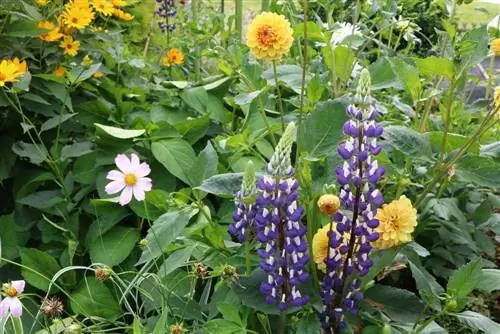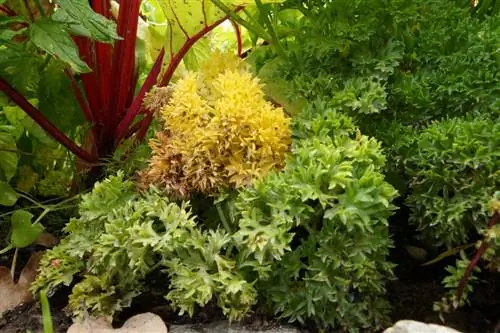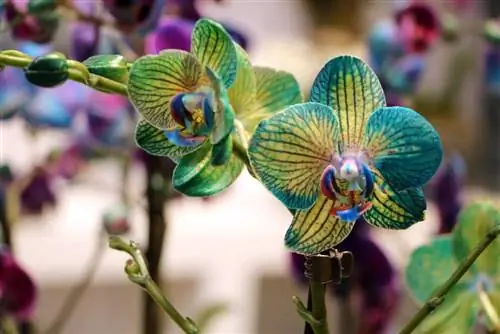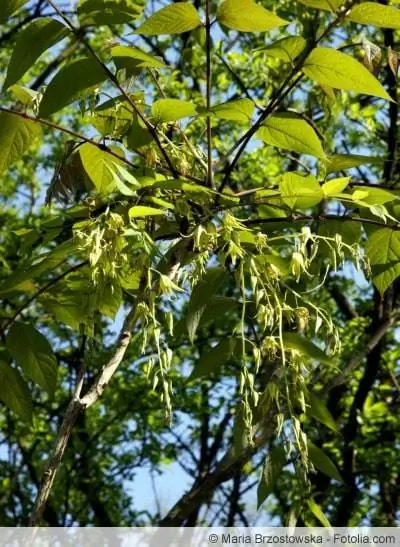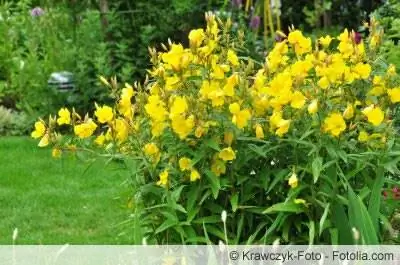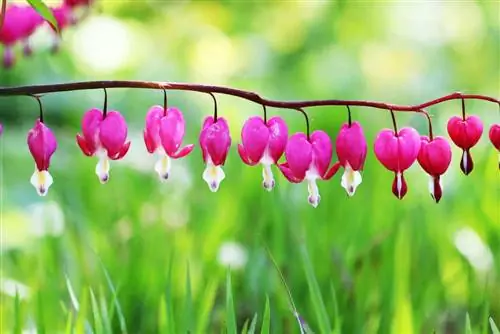- Author admin [email protected].
- Public 2023-12-17 03:39.
- Last modified 2025-06-01 06:48.
Yellow and blue lupins are considered indispensable classics in the garden. It is no coincidence that the large community of hobby gardeners is full of praise for the talented butterflies. The range of their advantageous attributes extends from unique decorative value to ecological preciousness. Their majestic flower candles create impressive accents, attract hordes of bees and butterflies and enrich the soil with nitrogen. The following instructions explain how you can sow and skillfully care for these botanical sparklers in your green kingdom.
Sowing
If you are already cultivating wolf beans, they and their legumes will provide numerous seeds for sowing in autumn. Whether yellow and blue lupins develop in the garden is like a horticultural roulette. Since these are usually hybrids, even experts cannot predict which genetic traits of the parent and grandparent plants will prevail in the individual seeds. If you want to be on the safe side, buy the seeds from specialist retailers, as the producer has made a selection in advance. In contrast to the colorful mixtures, you will of course have to dig a little deeper into your pockets. For the sowing itself, you have the choice between growing behind glass and direct sowing. Both methods are explained in more detail below.
Growing behind glass
You can sow yellow and blue lupins all year round in the greenhouse or on the windowsill. The best time is early to mid-April. How to do it right:
- Soak the seeds in water or chamomile tea for 12-24 hours
- Fill small pots with lean substrate, such as peat sand, coconut hum, seed or herb soil
- Place one seed at a time 1-2 cm deep into the soil
- Moisten with water from the spray bottle
- Place in an indoor greenhouse or in a bright, warm location
Germination begins within a week when the first, delicate leaves emerge from the seeds. Keep the substrate constantly moist without causing waterlogging. After about 4 weeks, the seeds have transformed into strong young plants that can be transplanted outdoors.
Tip:
To ensure that the seed soil is not infected with fungal spores, viruses or pests, it is disinfected before use. Place the substrate in the fireproof container in the oven at 150 degrees for 30 minutes or in the microwave at 800 watts for 10 minutes.
Sowing in a peat source pot
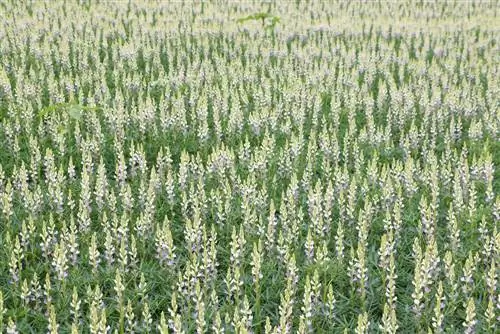
Peat soaking pots offer a convenient option for sowing in plastic pots. This is high-quality growing substrate that has been filled into a net and compressed. Laid out in a waterproof tray with a transparent hood, the tabs swell when water is added. Simply put the seeds in, put the lid on and place the entire bowl in a bright, warm place. Once germination has started, the hood has fulfilled its duty and the seedlings continue to thrive quickly. For watering, the water is poured into the mini greenhouse to gently water the young plants from below. After a month, the yellow and blue lupins are ready to be planted outdoors. At this point, another advantageous aspect of this method comes to light, because the wolf beans are placed in the ground together with the spring pot, without any stressful unpotting.
Tip:
The toxicity of lupine seeds should be taken into account in all planting and care work. Wearing gloves should be a given. Resist the temptation to snack on the juicy seeds unless you are completely sure you have a bitter-free sweet lupine in your hands.
Direct sowing
Where cultivation indoors is not practical, sowing directly into the bed is an option. Choose a sunny, warm and protected location that is characterized by humus-rich, loose soil. A low-lime pH value of around 6.5 is ideal. Soil that is too rich in nutrients causes undesirable yellowing of the foliage. Two dates come into consideration: May and August. Here's how to do it:
- Rake the soil deeply
- Weeding and carefully removing roots and stones
- Work in compost and horn shavings superficially
- Smooth the bed with the rake
- Place the soaked seeds in the soil at a distance of 50 cm
- Sift over with soil, sand or vermiculite and moisten
A stretched insect net protects the seedbed from uninvited guests. If the natural amount of rain is not sufficient, watering is carried out as soon as the soil surface dries. Unruly weeds should be pulled out daily if possible so that they do not overgrow the tender seedlings. Weak young plants are sorted out if necessary if they do not develop to the desired extent despite the administration of diluted liquid fertilizer.
Tip:
Crop rotation should be taken into account when choosing a location. Only sow yellow and blue lupins in the garden where no legumes such as peas, lentils or other colored lupins were previously established.
Care
If sowing and planting went as desired, caring for yellow and blue lupins in the garden requires little effort. A regular water supply is only important in the year of planting so that the deep taproots can become well established. The normal care protocol for an established lupine includes the following points:
- Watering in summer droughts
- Starting fertilization in March or April with compost and horn shavings is welcome
- A mulch layer of gravel or grit keeps the ground nice and warm
- Cleaning out faded flowers regularly always attracts new butterfly flowers
Pruning the stems down to 10 centimeters after flowering will, with a little luck, encourage a second flower, which will be a little smaller. In autumn, lupins pull in their above-ground plant parts to prepare for winter. Where the withered flowers and leaves do not cause any problems, they remain in the bed until next spring as additional winter protection. Shortly before the new shoots, the remains are cut off close to the ground.
Beautiful plant neighbors
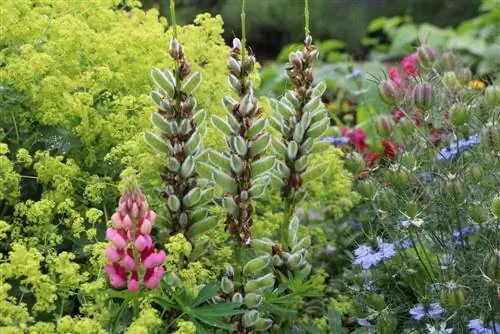
In the right company, the magnificent appearance of yellow and blue lupins is particularly impressive. The following plant neighbors harmonize perfectly with a wolf bean:
- Columbine (Aquilegia spec.)
- Foxglove (Digitalis purpurea)
- Gold basket (Chrysogonum virginianum)
- Globe thistle (Echinops ritro 'Veitch's Blue')
- Marguerite (Leucanthemum vulgare)
- Iris (Iris spec.)
- Forget-me-not (Myosotis sylvatica)
- Purple Mullein (Verbascum phoeniceum)
- White sweet clover (Melilotus albus)
Explicitly highlighted as neighbors to the blue lupine are the white-flowered meadow phlox (Phlox maculata 'Miss Lingard') and the silvery-blue catnip (Nepeta x faassenii 'Gletschereis'). The yellow-brown riding grass (Calamagrostis x acutiflora 'Karl Foerster'), the white fine-ray aster (Erigeron Speciosus hybrid 'Sommerneuschnee') and, for the tone-on-tone design, the yellow-flowering sun bride (Helenium hybrid) often gather around the yellow lupine 'W altraut').
Special feature - sweet lupine
Lupins in general are poisonous - but the related sweet lupine variety is not. Lupins are known as colorful flowering plants on the side of the road.
However, few people know that there are also varieties that could enrich our food industry. After all, their consumption is characterized by low calories and fat and it is also completely cholesterol and lactose free. In principle, you can say that sweet lupine is just as versatile as soy, but completely without genetic engineering. If you take the seeds of the sweet lupine and process them into flour, you can use it to keep bread fresh or stabilize foam, for example - in a completely natural way. That would be a dream for agriculture and food production: the implementation of lupins without genetic modifications for use in food production. Extracts of the plant are already found in a few foods. Lupins could permanently supplement or even completely replace soy in the diet in the next few years. It can also be easily used in the animal feed industry.
Taste of sweet lupins
you might mistakenly assume that the taste is sweet, but that is not the case. It's more in the direction of nutty - but very reserved, so it doesn't bother you, but in case of doubt it can even underline the taste of other types of fruit. Although the sweet lupine does not contain the toxic bitter substances like its sister, the wild lupine, it does contain minerals and fiber that are even said to prevent cancer. It is also extremely rich in protein. It also contains a valuable cholesterol called HDL, which has a positive effect on cholesterol levels and can therefore prevent a heart attack. Unfortunately, as is often the case, there is also a downside to the coin: allergy sufferers could react sensitively to the consumption of lupine flour, similar to peanuts.
Sowing sweet lupines in the garden - yellow and blue lupins
What about growing in your own garden? Incidentally, there is not yet a lot of experience with growing sweet lupins. If you want to grow it, you have to pay attention to the right soil conditions: it should be light and well-drained if possible. The PH value is ideally 4 - 6.5. Above 7 is no longer suitable for cultivation. Seeds are used for this purpose and if you have never grown lupins in the soil intended for this purpose, it is recommended that you first inoculate them with rhizobia strains specific to sweet lupins. You can order these with the seeds - for example on the Internet.
The best time to sow seeds is in spring, in March or April. The seeds should be planted about 3 or 4 cm deep in the soil - about 60 seeds per m² for white lupins, and about twice as many for blue lupins. The row spacing is 12 - 30 cm. There is no fertilization. There are different varieties on the market - for the blue lupins these are Bordako, Bolivio and Boltensia, for the white lupins Bardo or Amigo and for the yellow Borsefa Borsaja or Bormal. Blue lupins can tolerate frosts down to -4°C and white ones up to -8°C. So you can put them outdoors in the spring.
Sweet Lupine Care
Lupins need a lot of water both during germination and during flowering. They have a high heat requirement and have a vegetation period of 120 - 170 days, which again depends on the variety planted. The lupine has difficulty defending itself against weeds - but it is even more important to get to grips with them in a timely manner. In humid and warm weather there is a risk of the dreaded lupine disease anthracnose or follicle disease. Anyone who uses certified seeds can hope to prevent this disease.
Harvesting the Seeds
The seeds can be harvested in August/September - best with a combine harvester. (Setting the thresher similar to when harvesting peas). For storage, the harvested material should first be pre-dried.

Conclusion
Yellow and blue lupins enrich the garden with majestic flower candles, serve as a pasture for bees and butterflies and enrich the soil with valuable nitrogen. In order for the legumes to achieve this masterpiece over many years, professional sowing is just as fundamental as careful care. Since flexibility is one of the outstanding characteristics of lupins, you have the choice between growing them behind glass throughout the year or sowing the seeds directly into the bed in May or August. If the location is in a sunny, warm place with dry, lean and lime-poor soil, care is limited to regular watering in dry conditions.

